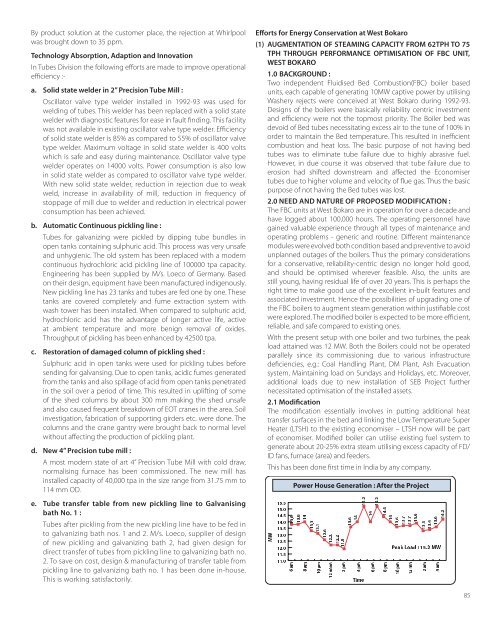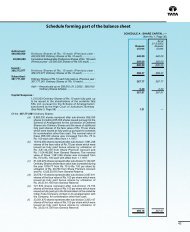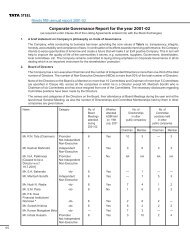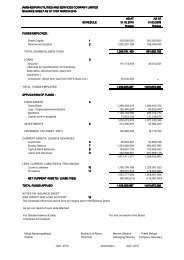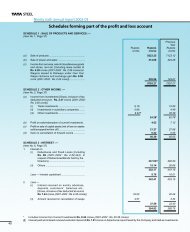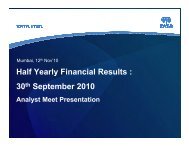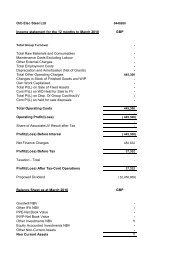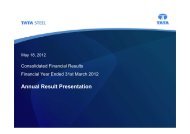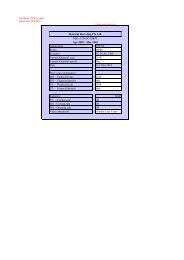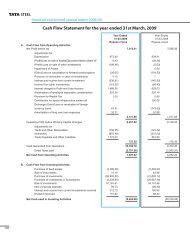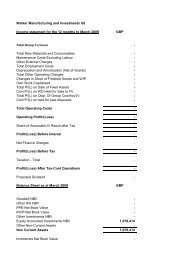100th Annual Report 2006-2007 - Tata Steel
100th Annual Report 2006-2007 - Tata Steel
100th Annual Report 2006-2007 - Tata Steel
You also want an ePaper? Increase the reach of your titles
YUMPU automatically turns print PDFs into web optimized ePapers that Google loves.
6 am<br />
2 pm<br />
12 noon<br />
10 am<br />
8 am<br />
8 pm<br />
6 pm<br />
4 pm<br />
10 pm<br />
4am<br />
2 am<br />
12 mn<br />
MW<br />
12.2 12.2<br />
12.6<br />
13.8 13.8<br />
14 13.1 13.3<br />
13.7 13.7<br />
13.6<br />
13.9 13.4 13.3<br />
By product solution at the customer place, the rejection at Whirlpool<br />
was brought down to 35 ppm.<br />
Technology Absorption, Adaption and Innovation<br />
In Tubes Division the following efforts are made to improve operational<br />
efficiency :-<br />
a. Solid state welder in 2” Precision Tube Mill :<br />
Oscillator valve type welder installed in 1992-93 was used for<br />
welding of tubes. This welder has been replaced with a solid state<br />
welder with diagnostic features for ease in fault finding. This facility<br />
was not available in existing oscillator valve type welder. Efficiency<br />
of solid state welder is 85% as compared to 55% of oscillator valve<br />
type welder. Maximum voltage in solid state welder is 400 volts<br />
which is safe and easy during maintenance. Oscillator valve type<br />
welder operates on 14000 volts. Power consumption is also low<br />
in solid state welder as compared to oscillator valve type welder.<br />
With new solid state welder, reduction in rejection due to weak<br />
weld, increase in availability of mill, reduction in frequency of<br />
stoppage of mill due to welder and reduction in electrical power<br />
consumption has been achieved.<br />
b. Automatic Continuous pickling line :<br />
Tubes for galvanizing were pickled by dipping tube bundles in<br />
open tanks containing sulphuric acid. This process was very unsafe<br />
and unhygienic. The old system has been replaced with a modern<br />
continuous hydrochloric acid pickling line of 100000 tpa capacity.<br />
Engineering has been supplied by M/s. Loeco of Germany. Based<br />
on their design, equipment have been manufactured indigenously.<br />
New pickling line has 23 tanks and tubes are fed one by one. These<br />
tanks are covered completely and fume extraction system with<br />
wash tower has been installed. When compared to sulphuric acid,<br />
hydrochloric acid has the advantage of longer active life, active<br />
at ambient temperature and more benign removal of oxides.<br />
Throughput of pickling has been enhanced by 42500 tpa.<br />
c. Restoration of damaged column of pickling shed :<br />
Sulphuric acid in open tanks were used for pickling tubes before<br />
sending for galvansing. Due to open tanks, acidic fumes generated<br />
from the tanks and also spillage of acid from open tanks penetrated<br />
in the soil over a period of time. This resulted in uplifting of some<br />
of the shed columns by about 300 mm making the shed unsafe<br />
and also caused frequent breakdown of EOT cranes in the area. Soil<br />
investigation, fabrication of supporting girders etc. were done. The<br />
columns and the crane gantry were brought back to normal level<br />
without affecting the production of pickling plant.<br />
d. New 4” Precision tube mill :<br />
A most modern state of art 4” Precision Tube Mill with cold draw,<br />
normalising furnace has been commissioned. The new mill has<br />
installed capacity of 40,000 tpa in the size range from 31.75 mm to<br />
114 mm OD.<br />
e. Tube transfer table from new pickling line to Galvanising<br />
bath No. 1 :<br />
Tubes after pickling from the new pickling line have to be fed in<br />
to galvanizing bath nos. 1 and 2. M/s. Loeco, supplier of design<br />
of new pickling and galvanizing bath 2, had given design for<br />
direct transfer of tubes from pickling line to galvanizing bath no.<br />
2. To save on cost, design & manufacturing of transfer table from<br />
pickling line to galvanizing bath no. 1 has been done in-house.<br />
This is working satisfactorily.<br />
Efforts for Energy Conservation at West Bokaro<br />
(1) AUGMENTATION OF STEAMING CAPACITY FROM 62TPH TO 75<br />
TPH THROUGH PERFORMANCE OPTIMISATION OF FBC UNIT,<br />
WEST BOKARO<br />
1.0 BACKGROUND :<br />
Two independent Fluidised Bed Combustion(FBC) boiler based<br />
units, each capable of generating 10MW captive power by utilising<br />
Washery rejects were conceived at West Bokaro during 1992-93.<br />
Designs of the boilers were basically reliability centric investment<br />
and efficiency were not the topmost priority. The Boiler bed was<br />
devoid of Bed tubes necessitating excess air to the tune of 100% in<br />
order to maintain the Bed temperature. This resulted in inefficient<br />
combustion and heat loss. The basic purpose of not having bed<br />
tubes was to eliminate tube failure due to highly abrasive fuel.<br />
However, in due course it was observed that tube failure due to<br />
erosion had shifted downstream and affected the Economiser<br />
tubes due to higher volume and velocity of flue gas. Thus the basic<br />
purpose of not having the Bed tubes was lost.<br />
2.0 NEED AND NATURE OF PROPOSED MODIFICATION :<br />
The FBC units at West Bokaro are in operation for over a decade and<br />
have logged about 100,000 hours. The operating personnel have<br />
gained valuable experience through all types of maintenance and<br />
operating problems - generic and routine. Different maintenance<br />
modules were evolved both condition based and preventive to avoid<br />
unplanned outages of the boilers. Thus the primary considerations<br />
for a conservative, reliability-centric design no longer hold good,<br />
and should be optimised wherever feasible. Also, the units are<br />
still young, having residual life of over 20 years. This is perhaps the<br />
right time to make good use of the excellent in-built features and<br />
associated investment. Hence the possibilities of upgrading one of<br />
the FBC boilers to augment steam generation within justifiable cost<br />
were explored. The modified boiler is expected to be more efficient,<br />
reliable, and safe compared to existing ones.<br />
With the present setup with one boiler and two turbines, the peak<br />
load attained was 12 MW. Both the Boilers could not be operated<br />
parallely since its commissioning due to various infrastructure<br />
deficiencies, e.g.: Coal Handling Plant, DM Plant, Ash Evacuation<br />
system, Maintaining load on Sundays and Holidays, etc. Moreover,<br />
additional loads due to new installation of SEB Project further<br />
necessitated optimisation of the installed assets.<br />
2.1 Modification<br />
The modification essentially involves in putting additional heat<br />
transfer surfaces in the bed and linking the Low Temperature Super<br />
Heater (LTSH) to the existing economiser – LTSH now will be part<br />
of economiser. Modified boiler can utilise existing fuel system to<br />
generate about 20-25% extra steam utilising excess capacity of FD/<br />
ID fans, furnace (area) and feeders.<br />
This has been done first time in India by any company.<br />
14.5 15.0 15.5<br />
14.0<br />
11.5 12.0 12.5 13.0 13.5<br />
11.0<br />
Power House Generation : After the Project<br />
13.614<br />
11.9<br />
14 15.2<br />
15.2<br />
1414.4<br />
13.6 14.2<br />
Peak Load : 15.2 MW<br />
85<br />
Time


